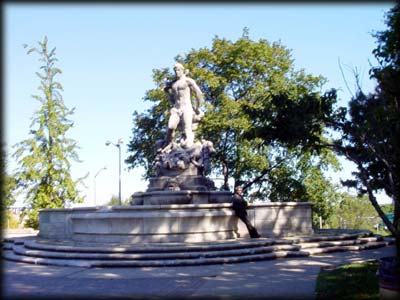Civic Virtue
Queens Boulevard at Union Turnpike
This marble fountain, which stands more than 20 feet high, depicts a male figure standing over two prone female figures, and was designed by sculptor Frederick MacMonnies (1863–1937) and carved by the Bronx’s Piccirilli Brothers. Although MacMonnies vehemently maintained that the piece is allegorical, from its unveiling in 1922 the fountain has been protested by people opposed to its literal and, some would say, violent imagery.
The funding for the sculpture materialized in 1891, following the death of New York resident Angelina Crane, who bequeathed money to the City to build a drinking fountain in her memory. After many delays, in 1909 the City commissioned MacMonnies to sculpt the fountain. MacMonnies did not finish final plans for the piece until 1919 and by the time the fountain was unveiled in 1922 in Manhattan’s City Hall Park, the social climate in America had changed drastically. The 19th Amendment provided for woman suffrage, and gender issues were at the forefront of public discourse. Suffice to say, MacMonnies’ brutal portrayal of Justice looking beyond the temptations of trampled female figures of vice was enough to set off a firestorm of dissent surrounding the sculpture.
For his part, MacMonnies insisted that portraying vice as female was in line with the allegorical representations of the day; others argued that the depiction was outdated and ultimately misogynistic. In 1941 Parks moved the statue from City Hall to its current location beside Queens Borough Hall. Standing at the corner of Queens Boulevard and Union Turnpike, it greets visitors to Queens’s seat of government and justice. Although no longer on parkland, Parks cares for and maintains the controversial piece and is searching for funding to conserve the historical work.
MacMonnies is well represented in New York’s parks, with a dozen pieces in Manhattan and Brooklyn. His contributions are particularly noticeable in Grand Army Plaza and Prospect Park. MacMonnies’s Horse Tamers (1899), the Army and Navy groups (1901 and 1902) and Quadriga (1901) on the Soldiers’ and Sailors’ Memorial Arch, Four Eagles (1898), and the bronze depiction of James S.T. Stranhan (1891), the father of Prospect Park, are major features of the adjoining sites. He worked with architect Stanford White on all of these pieces, and collaborated with him on Nathan Hale (1890) as well, which can be seen in Manhattan’s City Hall Park.
Friday, Feb 01, 2002
